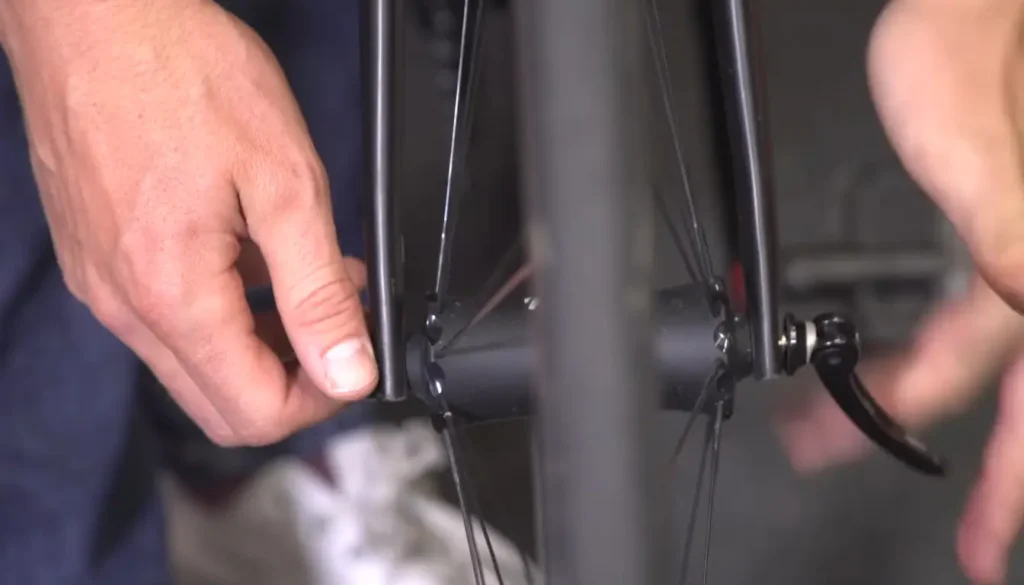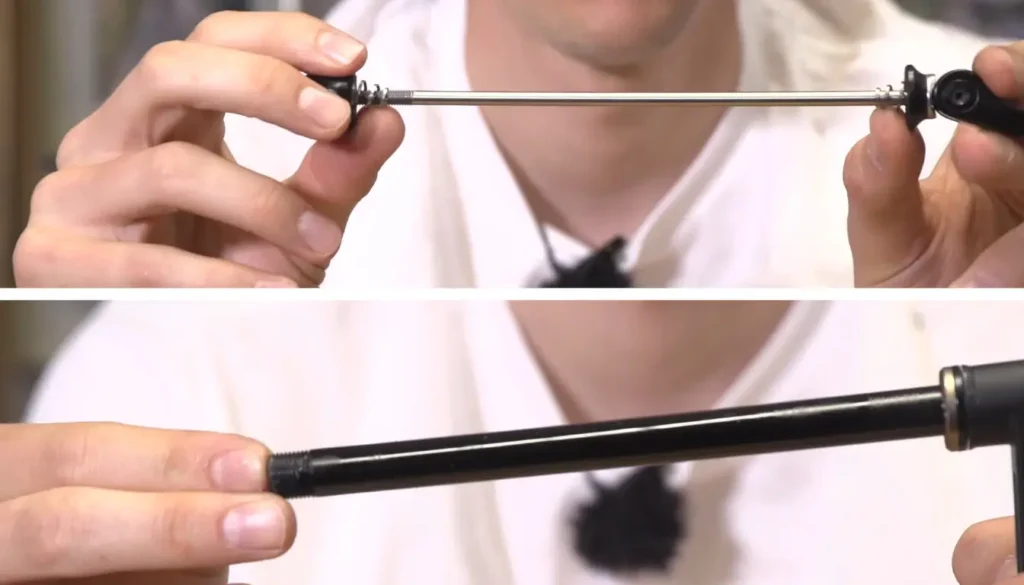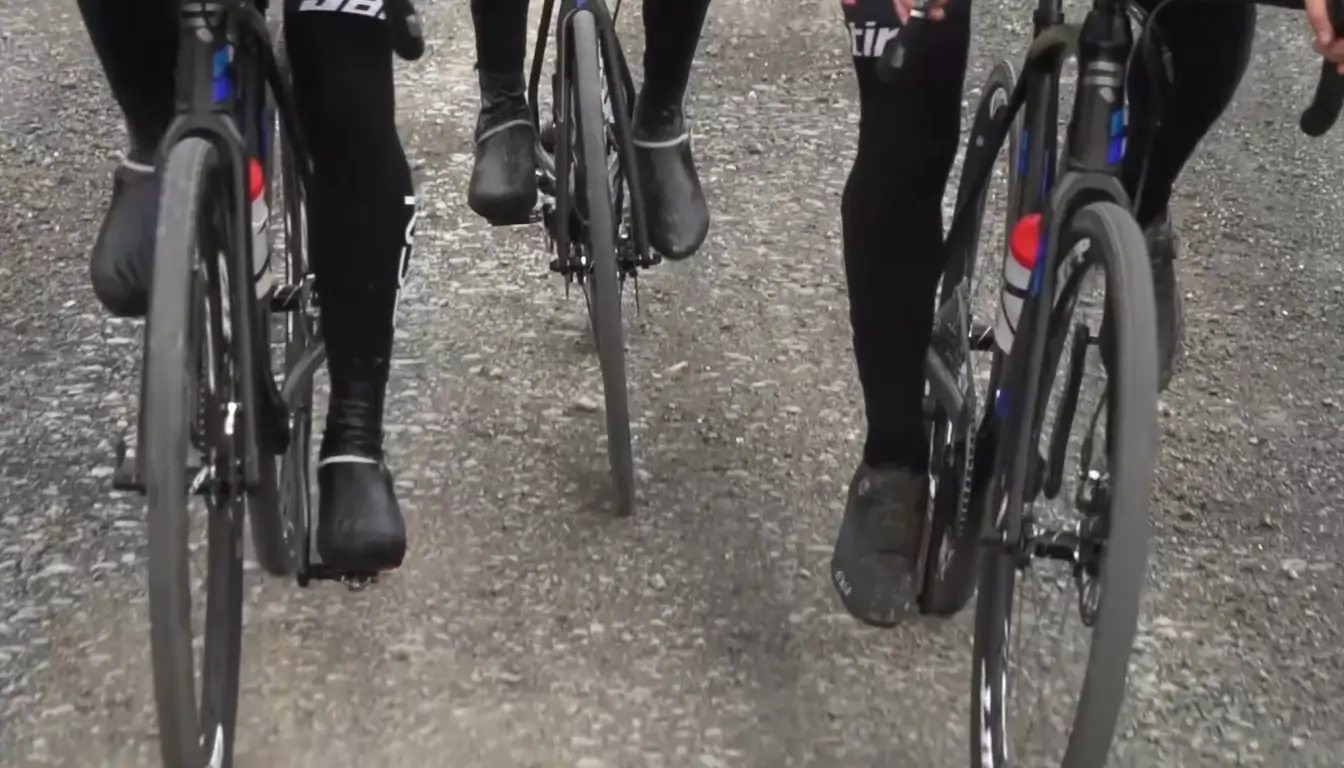The main difference between quick release vs thru axle is that the quick-release axle takes less time than the thru-axle to get attached to the frame or fork.
Axles are parts or components that are attached to mountain bike frames. They are mountain bike wheel attachment systems that get placed between the bike frame to secure the wheel’s position.
Quick-release axles do precisely as their name suggests. They are also attachment systems; they take less time and are more efficient if you don’t have time.
We go in-depth on the differences between quick-release and thru-axle wheel systems, so you know which one is the best fit for you.
Let’s get right into it.
What is a Quick Release Axle?
Most modern mountain bikes use this attachment system, as it is easier and more convenient.
Quick-release axles function and save time by attaching and detaching the wheels to the bike without the use of any components. Mountain bike frames have a lever with them called the “cam lever.” The lever is opened, and the bike is installed or removed.
You have to twist the lever, which will undo the quick-release skewer; this is also called the metal skewer, which secures the wheel’s position to the frame. The metal skewer is thin, so you have to be precise.
The average diameter of a quick-release axle is about 5-9mm; depending on the bike hubs, the size will vary.
Quick-release axles were invented and made by Tullio Campagnolo, a professional cyclist after he lost a race due to his wingnut. Because it was freezing, which caused the cyclist’s wingnut to fault, resulting in the loss.
The faulty wingnut cost him the race, leading to Tullio’s invention of quick-release axles. After almost 8 decades, quick-release axles became the new normal.
What is a Thru Axle?
Thru axles are another wheel-attaching system. It is a pin that has holes instead of slots. The pin is girthy and attaches itself to one end of the wheel to do its work.
Thru axles have circular-shaped dropouts rather than U-shaped dropouts for quick-release axles. The axle goes into the dropout and hub and threads itself one by one. It is time-consuming, indeed, but it confirms the wheels’ position in the most secure way possible.
Thru-axle goes directly through your frame’s holes and then screws the bolts. It’s practically impossible for your wheel to detach afterward. As the axle uses holes instead of slots, there’s no room for unwanted detachments.
Thru axles were discovered to tackle the consequences of quick-release axles. If you put it that way. You see, it was faster for quick-release axles, but it was easy to break too. Many off-road riders couldn’t ride smoothly with quick-release axles.
Quick-release axles had slots that would usually break, and MTBs started failing. After noticing the problem, thru axles were invented by the same person, Tullio Campagnolo, in the early 2000s.
Dropouts were replaced by holes instead of slots which made it impossible for the system to fail. The average diameter of a thru-axle is 15mm and could be resized according to needs.
Because of the part failure, almost every competitive mountain bike now uses thru-axles.
How to Identify a Quick Release and a Thru Axle?

If you’re new to this, identifying which is which could be difficult as it could get confusing. Which is totally normal; we have your back.
Quick Release Axle:
They always have levers. Quick-release axles have less thickness than thru-axles, which could be another way of identifying them. Quick-release axles have a diameter range of 5-9mm.
Quick-release axles have slots and a spring at the end. They have U-shaped dropout hubs.
Thru-axle:
Most of the time, they don’t have any levers. Even if they do, you can quickly identify by the thickness thru axles have significant girth than quick-release axles. The diameter range of thru axles is 15-20mm.
Thru axles have holes instead of slots and no springs attached to them. This helps in making firm wheel attachments. Thru axles have circular dropouts.
These are the basics that you need to look out for while identifying which is which; this may get challenging but gets easier.
What are the Advantages of Quick Release Axles?
Quick-release axles came before thru-axles, and although their presence might not be as much as earlier in bikes, they have some pros of using.
Inexpensive
Quick-release axles are way more inexpensive than thru-axles. We mean dirt cheap; a brand-new set of these axles can be found for $10 or less.
Less time consuming
The name gives it away, quick-release axles are quick and easy. It comes off within seconds; it’s that fast. As your wheels get detached, you don’t have to worry about the axles because the skewer stays inside the bicycle. Considering how easy and quick the process is, you can’t go wrong with it.
Parts availability
Most retro bikes have quick-release axles in them, as they were invented during the early 1900s. Even if you’re riding through woods or villages where there’s a population of 100 people, you’ll likely find a replacement for it. Besides, the replacement is cheap as well.
This is a major plus for quick-release axles as thru axles haven’t reached many countries yet.
Weight
Quick-release axles are significantly lighter than thru axles. Considering the part has spring and less thickness, it cuts down weight. An average quick-release axle weighs about 20-25 grams, whereas the thru axles could be 4 or 5 times the weight of quick-release axles.
Quick-release axles were a quick-fix solution. Tulio wasn’t thinking long-term until through axles. The motive behind them was for them to be easy for beginners, affordable, and for everyone to have access to it. Not rocket science stuff.
What are the Disadvantages of Quick Release Axle?
In today’s times, we wouldn’t even have thru-axles if quick-release axles didn’t fail. That says a lot about the part’s disadvantages. Let’s go deep into it.
More prone to accidents
Quick releases fail because of their adjustment. If it’s loose, it will come off while riding; if the QR comes off, the wheel will come off. This is extremely dangerous if the rider is going at high speed. This can lead to a nasty crash or, worse, death.
Many mountain bike manufacturers have been called out for faulty quick-release axles, resulting in lawsuits. In 2015, companies like Raleigh, Cannondale, GT, etc., were called for over 1.5 million MTBs that had quick-release axles that were too tight or faulty.
Tight QRs can cause the axle to fail too.
Pressures bike control
Quick-release axles allow flexibility, which might sound nice, but after many riding and races, professionals have found that it does more harm than good. The flexibility puts pressure on the mechanical disc brakes of the bike, which makes it harder for the rider to control the bike.
As there’s flexibility on the disc brakes, pressure will be put on the fork or frame, causing the brake pads to collide against each other. This is not a good sign.
Quick-release axles break easily.
Let’s say you are riding at a fast pace; this is putting pressure and stress on the axles. This pressure can cause the bike’s axle to snap or bend. If the axle breaks, the wheel comes off totally. And the wheel coming off entirely on a speeding mountain bike means death or a horrible injury to pay for a lifetime.
Outdated
As the axle has been here for a long time, it has primitive technology that is below today’s standards. The axle is not fast up to today’s times, but it sure could dominate a 1950 MTB race.
Most companies put thru-axles in their bikes; even if it’s a cheap one, it is there.
What are the Advantages of Thru Axles?
We could give twenty points on how thru-axles are a better option than QRs, but let’s keep a fair play and go over the crucial ones.
They are safe to ride.
It is impossible to have the possibility of wheels falling out of the bicycle while riding. That immediately makes the axles safer than quick-release ones. The dropouts can’t bother the pads as they are circular.
Besides, their structure is more firm and thick than QRs.
Thru axles don’t break.
Even if you are going at 20 mph, it’s implausible for the axle to bend, let alone break under stress and pressure. Sometimes full-suspension bikes with their suspension forks can break the axles with their placement, but with thru-axles, it can be prevented.
You can’t be a free rider and not go through bumps as you ride. These bumps put pressure on the axles, it might make the axle uncomfortable, but the thru axle won’t break.
Thru axles give stability to the bike.
Thru axles improve the overall riding experience by stabilizing the front end of the mountain bike. This means you no longer have unwanted flex in the front, and it won’t put pressure on the bike.
If your bike has a suspension fork, then the uneven compression will be eliminated by the thru-axle.
Thru axles also give proper wheel alignment to the wheel. While attaching with QRs, users have a possibility of an uneven position of the wheel, but as thru-axles have holes, you won’t have rough alignment.
They’re updated and modern.
They are upgraded, look sleek, are made out of premium material, and provide stability to your bike. What else could you ask for? Almost every competitive mountain bike has a thru-axle system nowadays.
Thru axles were the answer to every professional rider’s problems. Not only that, even an average quick-release user had a problem with the axle’s functioning. Something had to be done.
What are the Disadvantages of Thru Axles?
Now that you know the good stuff and how it will help you while riding. Here are some facts that are not so advantageous and might be a “no” for some people.
Expensive
Thru axles are undoubtedly more expensive than quick-release axles. A typical QR axle can be found for $8-10, whereas entry-level thru axles start at $30. If you want an average or just a standard thru-axle, you’ll have to spend $40-50.
The frames or forks of thru axles are more costly than QRs as they take more time and effort to install.
Parts unavailability
Unlike QRs, which you can find almost anywhere and everywhere, thru-axles are hard to find. Especially in developed countries where it hasn’t reached yet.
If you ride off-road or through mountains and small villages often, we recommend taking an extra thru-axle with you as it is unlikely that you’ll find the part in those areas. If something happens to the attachment system, you might get stuck due to a lack of parts.
They are heavy
Quick-release axles’ average weight is about 20-40 grams, whereas thru aisles start with 60 grams. The weight is variable according to size.
Thru axles have more thickness and require more parts than quick-release axles, so it’s natural for them to have more weight.
However, you can cut on weight by getting through axles with titanium or carbon fiber bodies which will cost more money. Nonetheless, the weight is not that significant, so you can skip getting a fancy frame part.
Time-consuming assembly
Again, it’s not that significant. The time is a matter of seconds. It takes a few more seconds than quick-release axles when it comes to removing or installing wheels to frames.
These extra seconds only matter in competitive racing, where a few seconds mean a few positions behind in the race. If you’re an everyday or free rider, you won’t have to worry about this.
Truth be told, thru axles could be too much for some riders. The only thing you’ll have to worry about is pressure or MTB wheels falling off if you’re going at high speed for a long time. Considering you don’t race or ride at 20mph in the mountains, you probably don’t even need a thru-axle.
Quick Release vs. Thru Axle: Which is better?

We have filled you in with every detail someone needs to know to decide, doesn’t matter if they’re new to biking or not. There is no such thing as “better” when it comes to parts, as each one is unique in its own way.
However, if you are confused about which to get, here’s how you can decide.
- If you ride recreationally (average-paced riding, transportation, not speeding too high, etc.), then we recommend sticking with quick-release axles.
- If you’re on a tight budget and want an attachment system, go for QRs.
- If you are a hardcore mountain biker (off-road, riding through rough trails, speeding up often, riding on elevated surfaces, racing, etc. ), go for thru-axles. As they are heavy-duty, they will provide more stability to your not-so-recreational rides.
- If you want an overall better experience and more control over your bike, spend some extra bucks and get thru-axles.
What matters is how you utilize the part, not which one is better. Thru axles are something that is mainly used by professionals who, of course, ride heavy.
Wrapping Up
Quick release and thru axles are both good at what they do, not overstepping anything. Quick-release axles were made to save time, but they weren’t the safest bike attachment part on the market.
Even though QRs are inexpensive, they could cause accidents. Thru axles eliminate the possibility of accidents by having a strong build, holes, and increasing mountain bike stability. We hope this post cleared your doubts.

